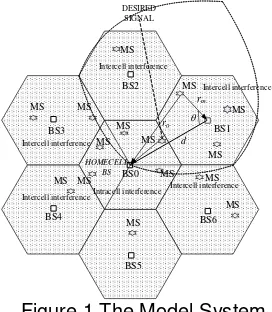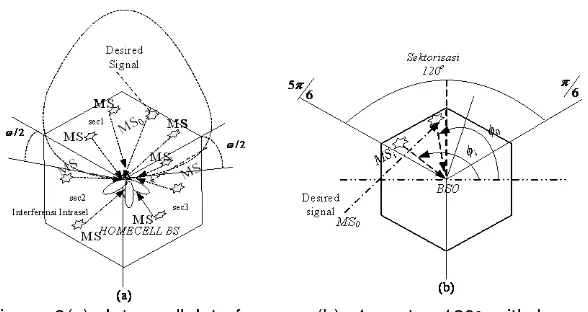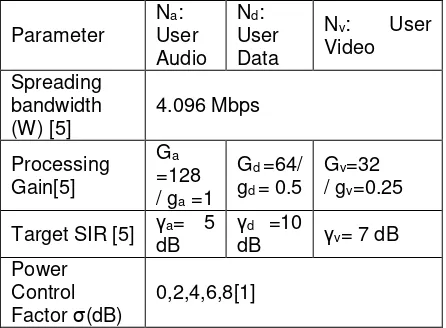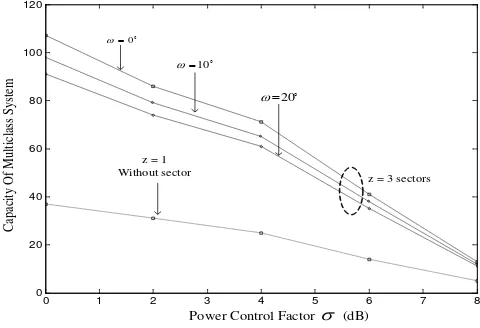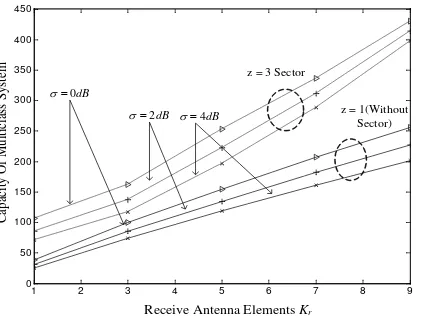157
The Impact of Beamforming, Power Control, and
Sectorization on CDMA Capacity
Linna Oktaviana Sari
Jurusan Elektro Fakultas Teknik Universitas Riau
e-mail: [email protected]
Abstrak
Kapasitas CDMA dibatasi oleh interferensi dan dapat dioptimalkan dengan menekan interferensi sehingga memenuhi kebutuhan layanan multiclass. Pada penelitian ini, dianalisa pengaruh penggunaan antena beamforming, pengendalian daya tak sempurna dan sektorisasi tak sempurna pada kapasitas user dari sistem CDMA reverse-link berdasarkan signal to interference ratio (SIR) pada pengirim mobile station (MS) dan penerima base station (BS). Beamforming digunakan dengan asumsi setiap elemen memiliki amplitudo arus identik dan jarak antar elemen yang sama. Sistem CDMA yang diteliti berbentuk sel makro heksagonal yang terdapat pada
homecell-BS dan dibagi kedalam 3 sektor dengan beamwidth 120o.Kapasitas user dipengaruhi oleh
faktor pengendalian daya, jumlah elemen antena beamforming, jumlah sektor, besar sudut overlap akibat sektorisasi tidak sempurna, dan pengendalian daya tak sempurna, SIR dan processing gain CDMA. Hasil Penelitian menunjukkan bahwa Pengendalian daya dan Sektorisasi dengan antena beamforming menghasilkan kapasitas sistem multiclass CDMA lebih besar dibandingkan tanpa antena beamforming.
Kata Kunci : Beamforming, Pengendalian daya, sektorisasi, Multiclass, CDMA.
Abstract
Capacity of CDMA was limited by interferences and could be optimalyzed by reduce interferences to fulfill requirements of multiclass services. In this research, the impact of imperfect power control and imperfect sectorization to reverse-link user capacity of CDMA system based on signal to interference ratio (SIR) by using beamforming at mobile station transmitter and base station receiver have been analyzed. Beamforming would be used with assumed each element has uniformly excited, equally spaced linear array. CDMA system use hexagonal macro cell in home cell base
station, which divided effectively into 3 sectors with 120o beam width. User capacities was influenced
by power control factor, number of antenna beamforming elements and sectors, overlap angle due to imperfect sectorization, imperfect power control, SIR and processing gain CDMA. Results of this research indicate that the system with power control and sectorization using beamforming has larger capacity of multiclass system than without beamforming.
Keywords: Beamforming, Power Control, Sectorization, Multiclass, CDMA.
1. Introduction
In the code division multiple access (CDMA) system, any user or mobile station (MS) using the same frequency at the same time, and only distinguished by the pseudo-noise code (PN-code) that cannot be perfectly orthogonal between users of one with others, resulting in interference between users [1] - [3]. CDMA capacity is limited by interference, so that to increase capacity by reducing interference. There are several methods to increase capacity, such as the power control (power control), sectorization, voice activity monitoring, beamforming (antenna arrays) and multiuser detection.
158
microcell with perfect/imperfect power control and perfect/imperfect sectorization. The results showed that the user capacity is more decrease if the imperfect power control and imperfect sectorization is increase. [4] have investigated the imperfect power control on reverse-link capacity of CDMA systems with fast power control and multipath fading. The results showed a reduction in user capacity due to the imperfect power control. In [5], the reverse-link capacity of CDMA systems using beamforming has been investigated. Beamforming was used at the sender and receiver, and power control was assumed by the signal to interference ratio (SIR). The results of this study indicate that an increase in capacity by using beamforming.
To support third-generation technology (3G), the CDMA has been selected as a technology for 3G systems to meet the service needs of audio, data, and video with a large capacity system. Audio, data and video services can be viewed as a multiclass CDMA system.
The result of imperfect sectorization is the interference increases then the capacity of multiclass CDMA system decreases. Therefore, to minimize the interference impact and increase capacity of multiclass CDMA system used beamforming for sectorization.
In this research, the effects of imperfect power control and imperfect sectorization in the reverse-link capacity of multiclass CDMA systems with beamforming have been analyzed. Beamforming is used at the sender and recipient of BS and MS is assumed each element have an identical current amplitude and have the same spacing between elements (uniformly excited, equally spaced linear array). Capacity was defined as the maximum number of users per cell that is affected the number of beamforming antenna elements, the number of sectors, and overlap angel due to imperfect sectorization, imperfect power control, SIR target, and processing gain CDMA.
2. Research Method
In this research, to analyze and calculate the capacity of multiclass CDMA system on the reverse link, there is a model system used in Figure 1. In the model system, the cells contained in home cell BS with BS0 and the ring (tier), the first consisting of cells that surround home cell BS with BSj, where j = 1,2, ... 6. Each BS is placed center of each macro cell is hexagonal. To analyze the influence of imperfect sectorization, then home cell BS is divided into several sectors by using antenna beamforming, where home cell BS is
divided into three sectors with an effective beamwidth of 120o.
R
c
BS1
BS0
BS4 BS3
BS2
BS1
BS5
BS6 MS
d r0
rm
MS
HOMECELL BS
MS
MS DESIRED SIGNAL
Intercell interference
Intracell interference MS
MS
MS
Intercell interference
Intercell interference
Intercell interference MS
MS
MS Intercell interference
MS MS
MS MS
MS
159
Figure 2(a). Intra cell Interference, (b). 1 sector 120o with beamforming
antenna.
In Figure 2(a), intra cell interference on home cell BS, derived from a number of MS present in these cells. When home cell BS is sectorized and beamforming antennas is used, as shown in Figure 2(b), then the amount of interference from the user would
decrease. In Figure 2 (b) indicated angel notations of BS0 beamforming receiver,
0 is theazimuth angle from MS0 to BS0 and
iis the azimuth angle of the MSi to BS0, these anglesevenly distributed from
6
5
6
to
for the three sectors. Gain antenna toward thereceiver from MS0 to MSi BS0 for three sectors is given by [5]:
0.5
5 . 0
2 2
2
0 ,
5 . 0 sin
5 . 0 sin ,
0
f d
K K G
E G
r r i
r
r i
(1)
By using beamforming antenna, the total of intra cell interferences for sectorization with beamforming becomes:
r N
i i z
t r s F S G
S .
1
1
(2)
Where
0
360 1
z
S S F
sektor non
sektor z
z is number of sector, and ω is overlap angel between sektor [3].
Figure 3.Sectorization 3 sector with beamforming and angel notations ofbeamforming.
In Figure 3 is shown home cell BS sectorize into 3 sectors with 120o beamwidth
160
beamforming antenna is also used on the MSi, j, then the total inter cell interference with sectorization Sz at BS0 can be expressed by
angle of BSj to BS0. In Figure 3 is shown angel notations on the sender beamforming at MSI, j. When there is a sender Kt beamforming antenna element in MS, then the antenna gain of sender in the direction MSi, j to BS0 [5] is
If there are elements of the receiving antenna beamforming Kr at BS0 to receive signals from ms0, then the gain of the receiving antenna from MSi,j to BS0 [5] is
2
In this research, each traffic audio, data, and video on multiclass CDMA system
uses a different spreading code with processeing gain Ga, Gd, and Gv. In this way, the
services with different rates are accommodated with a spreading sequence with a variety
of processing gain. If the processing gain is normalized by G = Ga, then the processing
gain has been normalized to the audio, data, and video services into ga, gd, and gv .The
Three types of spreading sequences with different processing gain Gga, Ggd, dan
Ggv used to meet the needs of the different rate. To achieve the target SIR (γa, γd, γv) for
different services, and Pa, Pd, and Pv is the power received for each service, where Sa =
Paga, Sd = Pdgd ,and Sv = Pvgv is a normalization of the power received for each traffic audio,
data, and video, so that the Eb/Io multiclass CDMA system for each class:
161
sectorization Sz in multiclass system can be rewritten into the following equation:]
3. Results and Analysis
The parameters used in calculating the capacity of user audio, data, and video on multiclass system is shown in Table 4.1:
Table 4.1 Parameters.
Parameter
Na:
Spreading bandwidth (W) [5]
4.096 Mbps
Processing Gain[5] Control
Factor σ(dB)
162
Konstanta
Propagasi (μ) 4[1]
Elemen Antena Penerima[5];
1 - 9
Elemen Antena Pengirim[5];
1 - 4
Sudut
Overlap (˚) 0;5;10;15[3];20
Jumlah
Sektor (z)[3] 3
3.1. The Impact of Power Control and Sectorization on CDMA Multiclass System Capacity.
Figure 4 shows the capacity of multiclass system towards effect of power control. Multiclass system capacity with z = 3 sector compared to the system without sectorization. From Figure 4 shows that the capacity of either without or with sectorization decreased with decreasing the effect of power control. As the result of the increasing imperfect power control, the signal interference between users is also increase. The increase means a
decrease Eb/I0 interference signals that can be used to represent the value of SIR. To
achieve the target SIR or the desired signal quality then there is a decrease in system capacity.
0 1 2 3 4 5 6 7 8
0 20 40 60 80 100 120
Power Control Factor
0
20
z = 1 Without sector
z = 3 sectors
10
C
ap
ac
ity
O
f
M
ul
tic
la
ss
S
ys
te
m
(dB)
Figure 4 Multiclass System Capacity as a function of power control
For sectorization z = 1 sector and z = 3 sectors,
0
,
10
,
20
.In Figure 4 is also shown that by imperfect sectorization z = 3 sectors and perfect
sectorization (
0
), then the system capacity increase compared to the capacity of thesystem without sectorization. This occurs because the user on the multiclass system is only serviced by BS which antenna sector is facing the user. As a result, those users are only getting signal interference from users of the same sector. If there are overlap between
sectors
10
and
20
, the sectorization increasingly imperfect so that systemcapacity decreased compared to perfect sectorization. This occurs because the user is also getting signal interference from some user in other sector. However, In Figure 4 shown that the system capacity with the overlap between sectors is larger than without sectorization.
163
Figure 5 shows the effect of addition of element receiving beamforming antenna Kr
on the capacity of multiclass system. On BS, the antenna element receiver Kr increases
from 1, 3, 5, 7 until 9. While at MS,the antenna element sender Kt = 1. Effect of power
control on system capacity indicated by
0
dB,
2
dB, and
4
dB.1 2 3 4 5 6 7 8 9
0 50 100 150 200 250 300 350 400 450
Receive Antenna Elements Kr
C
ap
ac
it
y
O
f
M
u
lt
ic
la
ss
S
y
st
em
z = 1(Without Sector) z = 3 Sector
dB 0
dB 2
4dB
Figure 5.Capacity of multiclass system as a function of receiver antenna
elements beamforming Kr, for Kt =1, with power control and sectorization.
Effect of Kr on the capacity of multiclass system is shown without sectorization z =
1 and by performing a perfect sectorization z = 3, In Figure 5 shows that the capacity of multiclass systems with sectorization and beamforming greater than without sectorization.
For imperfect power control with
4
dB, the multiclass system capacity increase withthe increase in the number of receiver antenna elements beamforming Kr compared to
perfect power control
0
dB using only one receiver antenna at the BS. This occursbecause by adding receiver antenna elements beamforming at the BS for transmitting reverse link, signals from antenna elements are combined to form a movable beam pattern that can lead to the desired destination to follow the movement of MS. Thereby enabling the antenna system to focus radio frequency (RF) at a particular MS and minimize the impact of interference by increasing system capacity.
4. Conclusion
Sectorization with beamforming antennas produce a multiclass system capacity is greater than the use of beamforming antennas without sectorization. Imperfect sectorization can reduce the capacity of multiclass system, with the use of beamforming antennas in imperfect sectorization, can increase the capacity of multiclass system.
References
[1] K. S. Gilhousen, I. M. Jacobs, R. Padovani, A. J. Viterbi, L.A. Weaver Jr., and C. E. Wheatly III,
“On the capacity of a CDMA system,” IEEE Trans on Veh. Technol., vol. 40, no. 2, pp. 303–
312, Mei 1991.
[2] [2] R. Prasad, M.G. Jansen, A.Kegel, “Capacity Analysis of Cellular Direct Sequence Code
Division Multiple Access System With Imperfect Power Control”, IEICE TRANS .COMMUN,
Vol.E76-B, No.8, Agustus 1993.
[3] [3]. Jie Zhou,Y.Onozato,U.Yamamoto,” On the Capacity and Outage Probability of a CDMA
Hierarchical Mobile System with Perfect/Imperfect Power Control and Sectorization”, IEICE
TRANS FUNDAMENTALS, Vol.E82-A,No.7, July 1999.
[4] [4]. Juan M. Romero-Jerez, C.Tellez-Labao, A.Diaz-Estrella,”Effect of Power Control
Imperfections on the Reverse Link of Cellular CDMA Networks Under Multipath Fading”, IEEE
Trans on Veh. Technol., vol. 53, no.1, Januari 2004.
[5] [5]. Jin Yu, Yu-Dong Yao, Jinyun Zhang, “ Reverse-Link Capacity of Power-Controlled CDMA
